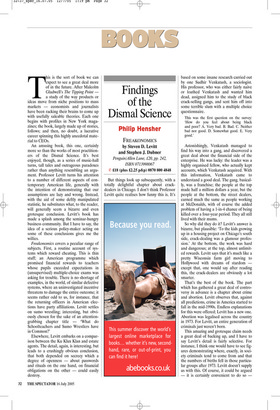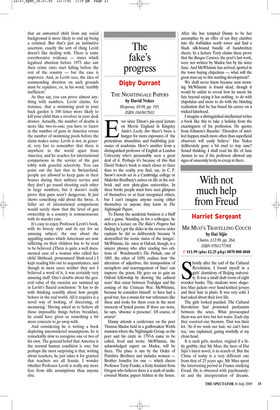Findings of the Dismal Science
Philip Hensher
FREAKONOMICS by Steven D. Levitt and Stephen J. Dubner Penguin/Allen Lane, £20, pp. 242, ISBN 0713998067 ✆ £18 (plus £2.25 p&p) 0870 800 4848 But things look up subsequently, with a totally delightful chapter about crackdealers in Chicago. I don’t think Professor Levitt quite realises how funny this is. It’s This is the sort of book we can expect to see a great deal more of in the future. After Malcolm Gladwell’s The Tipping Point a study of the way products or ideas move from niche positions to mass markets — economists and journalists have been racking their brains to come up with usefully saleable theories. Each one begins with profiles in New York magazines; the book, largely made up of stories, follows; and then, no doubt, a lucrative career spinning this highly anecdotal material to CEOs.
An amusing book, this one, certainly more so than the works of most practitioners of the Dismal Science. It’s best enjoyed, though, as a series of music-hall turns, tall tales and outrageous paradoxes rather than anything resembling an argument. Professor Levitt turns his attention to a number of different aspects of contemporary American life, generally with the intention of demonstrating that our assumptions are lazy and wrong. Instead, with the aid of some deftly manipulated statistic, he substitutes what, to the reader, will generally seem a bizarre and even grotesque conclusion. Levitt’s book has made a splash among the seminar-hungry business community. But I have to say, the idea of a serious policy-maker acting on some of these conclusions gives me the willies.
Freakonomics covers a peculiar range of subjects. First, a routine account of systems which reward cheating. This is thin stuff; an American programme which promised financial rewards to teachers whose pupils exceeded expectations in (unsupervised) multiple-choice exams was asking for trouble. There is no shortage of examples, in the world, of similar defective systems, where an uninvestigated incentive threatens to damage the entire outcome; it seems rather odd to us, for instance, that the returning officers in American elections have party affiliations. Levitt settles on sumo wrestling; interesting, but obviously chosen for the sake of an attentiongrabbing chapter title — ‘What do Schoolteachers and Sumo Wrestlers have in Common?’ Elsewhere, Levitt embarks on a comparison between the Ku Klux Klan and estate agents. The detail, again, is interesting, but leads to a crushingly obvious conclusion, that both depended on secrecy which a degree of openness — about passwords and rituals on the one hand, on financial obligations on the other — could easily destroy. based on some insane research carried out by one Sudhir Venkatash, a sociologist. His professor, who was either fairly naive or loathed Venkatash and wanted him dead, assigned him to the study of black crack-selling gangs, and sent him off into some terrible slum with a multiple choice questionnaire.
This was the first question on the survey: ‘How do you feel about being black and poor? A. Very bad. B. Bad. C. Neither bad nor good. D. Somewhat good. E. Very good.’
Astonishingly, Venkatash managed to find his way into a gang, and discovered a great deal about the financial side of the enterprise. He was lucky: the leader was a highly organised fellow, who actually kept accounts, which Venkatash acquired. With this information, Venkatash came to understand a good deal. The gang, basically, was a franchise; the people at the top made half a million dollars a year, but the people at the bottom, the street dealers, earned much the same as people working at McDonalds, with of course the added problem of having a 1-in-4 chance of being killed over a four-year period. They all still lived with their mums.
So why did they do it? Levitt’s answer is bizarre, but plausible: ‘To the kids growing up in a housing project on Chicago’s south side, crack-dealing was a glamour profession.’ At the bottom, the work was hard and dangerous; at the top, almost unlimited rewards. Levitt says that it’s much like a pretty Wisconsin farm girl moving to Hollywood with dreams of stardom except that, one would say after reading this, the crack-dealers are obviously a lot smarter.
That’s the best of the book. The part which has gathered a great deal of controversy in advance is a chapter about crime and abortion. Levitt observes that, against all predictions, crime in America started to fall in the mid-1990s. Endless explanations for this were offered; Levitt has a new one. Abortion was legalised across the country in 1973. For Levitt, an entire generation of criminals just weren’t born.
This amazing and grotesque claim needs a great deal of backing up, and I have to say Levitt’s detail is fairly selective. For instance, I think one would have to see figures demonstrating where, exactly, in society criminals tend to come from and that the numbers of births fell in those particular groups after 1973. Levitt doesn’t supply us with this. Of course, it could be argued — it is certainly convenient to do so — that an unwanted child from any social background is more likely to end up being a criminal. But that’s just an instinctive assertion, exactly the sort of thing Levitt doesn’t like dealing with. There is some corroborative evidence — states which legalised abortion before 1973 also saw their crime rates start falling before the rest of the country — but the case is unproven. And, as Levitt sees, the idea of commending abortion on such grounds must be repulsive, or, in his word, ‘terribly inefficient’.
As they say, you can prove almost anything with numbers. Levitt claims, for instance, that a swimming pool in your back garden is 100 times more likely to kill your child than a revolver in your desk drawer. Actually, the number of deaths is more like two-to-one; you have to factor in the number of guns in America versus the number of swimming pools before the claim makes sense. Levitt is not, in general, very fast to remember that there is anywhere in the world apart from America, and he reaches for international comparisons in the service of the gun lobby with grateful selectivity. You can point out the fact that in Switzerland, people are allowed to keep guns in their houses during their military service and they don’t go round shooting each other in large numbers, but it doesn’t really prove that guns aren’t dangerous. It just shows something odd about the Swiss. A fuller set of international comparisons would surely show that the level of gun ownership in a country is commensurate with its murder rate.
It’s easy to enjoy Professor Levitt’s book, with its breezy style and its eye for an amusing subject; the one about the appalling names which Americans are now inflicting on their children has to be read to be believed. (There is quite a well documented case of a woman who called her child Shithead, pronounced Shuh-teed.) I kept reading bits out to acquaintances, and though in most cases neither they nor I believed a word of it, it was certainly very amusing stuff. One’s doubts about the general value of the exercise are summed up in Levitt’s flaccid conclusion: ‘It has to do with thinking sensibly about how people behave in the real world. All it requires is a novel way of looking, of discerning, of measuring.’ Having asked us to believe all those impossible things before breakfast, he could have given us something a bit more concrete to go away with.
And considering he is writing a book deploring unconsidered assumptions, he is remarkably slow to recognise one or two of his own. The general belief that America is the normal human condition is one; but perhaps the most surprising is that, writing about teachers, he just takes it for granted that teachers are all female. I wonder whether Professor Levitt is really any more free from idle assumptions than anyone else.



























































 Previous page
Previous page